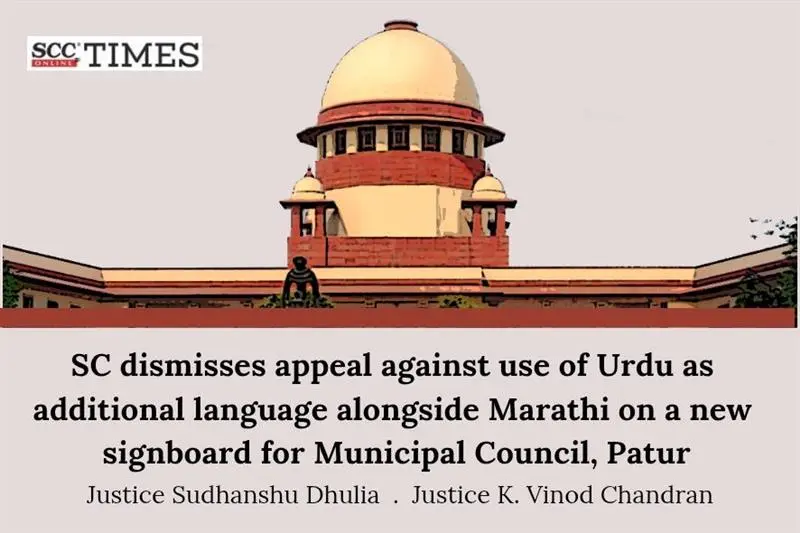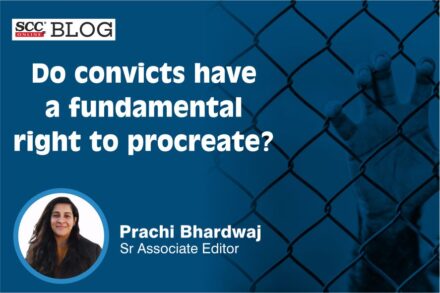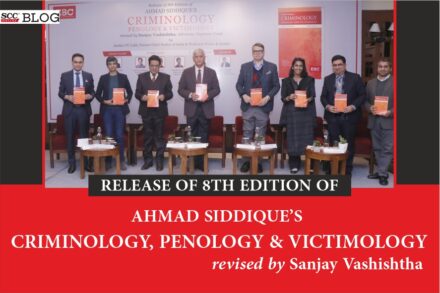Supreme Court: In the instant matter, the appellant had been aggrieved at the use of Urdu on the signboard of the new building of the Municipal Council, Patur (‘Municipal Council’) in district Akola, Maharashtra, the board of the Council displayed “Municipal Council, Patur”, in Marathi at the top, with its translation below in Urdu language. The Division Bench of Sudhanshu Dhulia* and K. Vinod Chandran, JJ., while dismissing the appeal, held that display of an additional language cannot by itself, be said to be in violation of the provisions of the Maharashtra Local Authorities (Official Languages) Act, 2022 (‘2022 Act’) as there is no prohibition on the use of Urdu under the 2022 Act or in any provision of law.
The Court further said that a Municipal Council is there to provide services to the local community of the area and cater to their immediate day-to-day needs. If people or a group of people, residing within the area covered by the Municipal Council are familiar with Urdu, then there should not be any objection if Urdu is used in addition to the official language i.e. Marathi, at least on the signboard of the Municipal Council. Language is a medium for exchange of ideas that brings people holding diverse views and beliefs closer and it should not become a cause of their division.
Background and Legal Trajectory:
The appellant who is a former member of the Municipal Council, contended the work of the Municipal Council can only be conducted in Marathi, and the use of Urdu in any manner is impermissible, even though it may just be a writing on the signboard of the Municipal Council.
The appellant first raised her objection before the Municipal Council itself. The Council made its deliberations on the question raised by the appellant and ultimately through its resolution dated 14-02-2020, the Municipal Council rejected the appellant’s objection by a majority, and it was resolved that the use of Urdu in addition to Marathi on the signboard of the Municipal Council was perfectly justified.
Dissatisfied with the afore-stated resolution, the appellant moved an application under Section 308 of the Maharashtra Municipal Council, Nagar Panchayats and Industrial Township Act, 1965 (‘1965 Act’) before the Collector Akola, praying for setting aside of the Municipal Council’s resolution. This application was allowed, and the Council was directed “Rajbhasha Marathi shall be used 100% in the Government proceedings”.
Some Members of the Council challenged the Collector’s order before the Divisional Commissioner, Amravati in revision under Section 318 of the 1965 Act and subsequently, the Collector’s order was set aside.
Aggrieved, the appellant filed a writ petition before Bombay High Court, which was dismissed. Hence, the appellant approached the Supreme Court. The appellant submitted that during the pendency of this matter, a new legislation i.e. the Maharashtra Local Authorities (Official Languages) Act, 2022 (2022 Act) had been enacted in terms of which, the use of Urdu language on the signboard of the Municipal Council is not permitted. Consequently, the matter was again heard by the Division Bench of Bombay High Court. The Court in its impugned order dismissed the petition holding that till such time, Marathi language continues to be the official language of the Local Authorities, in terms of the Act of 2022, the use of an additional language to display the name of Municipal Council on its building would not indicate any violation of the provisions of the Act of 2022.
Court’s Assessment:
Perusing the issue and its legal trajectory, the Court at the very outset held that the High Court had rightly concluded that the 2022 Act, on which the appellant placed significant reliance, does not prohibit the use of an additional language (which is Urdu in the present case) on the signboard of the Municipal Council building.
The Court elucidated that there is no prohibition on using any other language, especially one included in the 8th Schedule of the Constitution. Section 3(2) of the 2022 Act is an enabling provision to use English in situations where the communications, in which the subject matter of the communication cannot be properly conveyed in Marathi or in situations where the persons to whom such communications are addressed cannot understand Marathi. This makes it more than explicit that even the enactment recognizes that language essentially is a tool of communication; which, cannot be condemned, when this language is being used by a community or group.
“We have to emphasize that Marathi and Urdu occupy the same position under Schedule VIII of the Constitution”.
The Court said that the appellant is a fellow citizen who has taken great pains to take this matter twice to the High Court and then twice again before the Supreme Court.
“What the appellant thinks may also be the thinking of many of our fellow citizens. These need to be addressed”.
The Court stated that language is the yardstick to measure the civilizational march of a community and its people. So is the case of Urdu, which is the finest specimen of Ganga-Jamuni Tahzeeb, or the Hindustani Tahzeeb, which is the composite cultural ethos of the plains of Northern and Central India. However, before language became a tool for learning, its earliest and primary purpose will always remain communication.
“Language is not religion. Language does not even represent religion. Language belongs to a community, to a region, to people; and not to a religion”.
Perusing the instant case, the Court pointed out that case, the purpose here for the use of Urdu was merely communication. All the municipal council wanted to do was to make an effective communication. This is the primary purpose of a language, which the Bombay High Court had laid emphasis on.
The Court pointed out that the Constitution though mentions twenty-two Indian languages in its 8th Schedule, which includes both Marathi and Urdu, and significantly, ‘English’ is not a language mentioned in the Schedule as it is not an Indian language. With this linguistic diversity, India is the most multilingual country in the world.
“We, the people of India, have taken great pain in resolving the language issue at the Centre, which is our unique achievement considering the linguistic diversity of the nation as we have been mentioning repeatedly”.
Delving into Part XVII of the Constitution, which deals with the official language. Article 351 emphasizes on the spread of Hindi language and to develop the language, inter alia, by assimilating the forms and style and expressions used in “Hindustani” and other languages of the 8th Schedule and wherever necessary or desirable, by drawing vocabulary, primarily from Sanskrit but also secondarily from other languages. Article 345 empowers State legislatures to adopt Hindi or any other language in use in that State as the official language of that State.
The Court stated that the prejudice against Urdu stems from the misconception that Urdu is alien to India. “This opinion, we are afraid, is incorrect as Urdu, like Marathi and Hindi, is an Indo-Aryan language. It is a language which was born in this land”. Urdu developed and flourished in India due to the need for people belonging to different cultural milieus who wanted to exchange ideas and communicate amongst themselves.
Delving into the Constituent Assembly Debates around the issue of language, the Court noted that, “Why was it then that Hindustani was not recognized as an official language of the Union? It is now clear that the main reason behind this was the partition of the nation in 1947 and adoption of Urdu by Pakistan as its National language. The ultimate victim was Hindustani”. Under Article 343 of the Constitution, Hindi is the official language, while the use of English was made permissible for official purposes for a period of fifteen years. However, this does not mean that Hindustan and Urdu have become extinct. This was never the intention of the framers of the Constitution.
The Court pointed out that even today, the language used by the common people of the country is replete with words of the Urdu language, even if one is not aware of it. It would not be incorrect to say that one cannot have a day-to-day conversation in Hindi without using words of Urdu or words derived from Urdu. “The word ‘Hindi’ itself comes from the Persian word ‘Hindavi’! This exchange of vocabulary flows both ways because Urdu also has many words borrowed from other Indian languages, including Sanskrit”. Furthermore, Urdu words have a heavy influence on Court parlance, both in criminal and civil law. From Adalat to halafnama to peshi, the influence of Urdu is writ large in the language of the Indian Courts.
From a Constitutional perspective, the use of language for official purposes is not according to any rigid formula. For example, Article 120 of the Constitution prescribes Hindi or English as the official language of Parliament, but the proviso to the said Article empowers the Presiding Officer of the House to allow a member to express themselves in their mother tongue, if they do not know Hindi or English. The same principle applies to State legislatures vide Article 210 of the Constitution.
The Court pointed out that Urdu and Hindi have broad similarities in their syntax, their grammar and their phonology. However, this fusion of the two languages Hindi and Urdu met a roadblock in the form of the puritans on both sides and Hindi became more Sanskritized and Urdu more Persian.
“A schism exploited by the colonial powers in dividing the two languages on religion. Hindi was now understood to be the language of Hindus and Urdu of the Muslims, which is such a pitiable digression from reality; from unity in diversity; and the concept of universal brotherhood”.
It its concluding remarks, the Court urged that our misconceptions, perhaps even our prejudices against a language have to be courageously and truthfully tested against the reality, which is this great diversity of India: “Our strength can never be our weakness. Let us make friends with Urdu and every language”.
[Varshatai v. State of Maharashtra, 2025 SCC OnLine SC 778, decided on 15-4-2025]
*Judgment by Justice Sudhanshu Dhulia
Advocates who appeared in this case :
For Petitioner(s): Mr. Kunal Cheema, AOR Mr. Satyajeetsingh Raghuwanshi, Adv. Mr. Raghav Deshpande, Adv.
For Respondent(s): Ms. Preet S. Phanse, Adv. Mr. Siddharth Dharmadhikari, Adv. Mr. Aaditya Aniruddha Pande, AOR







